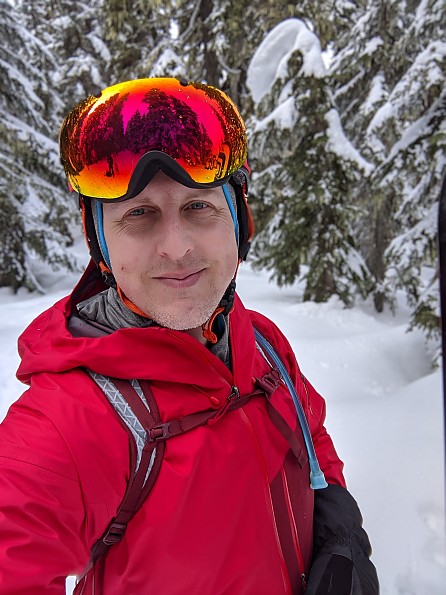Patagonia SnowDrifter Jacket
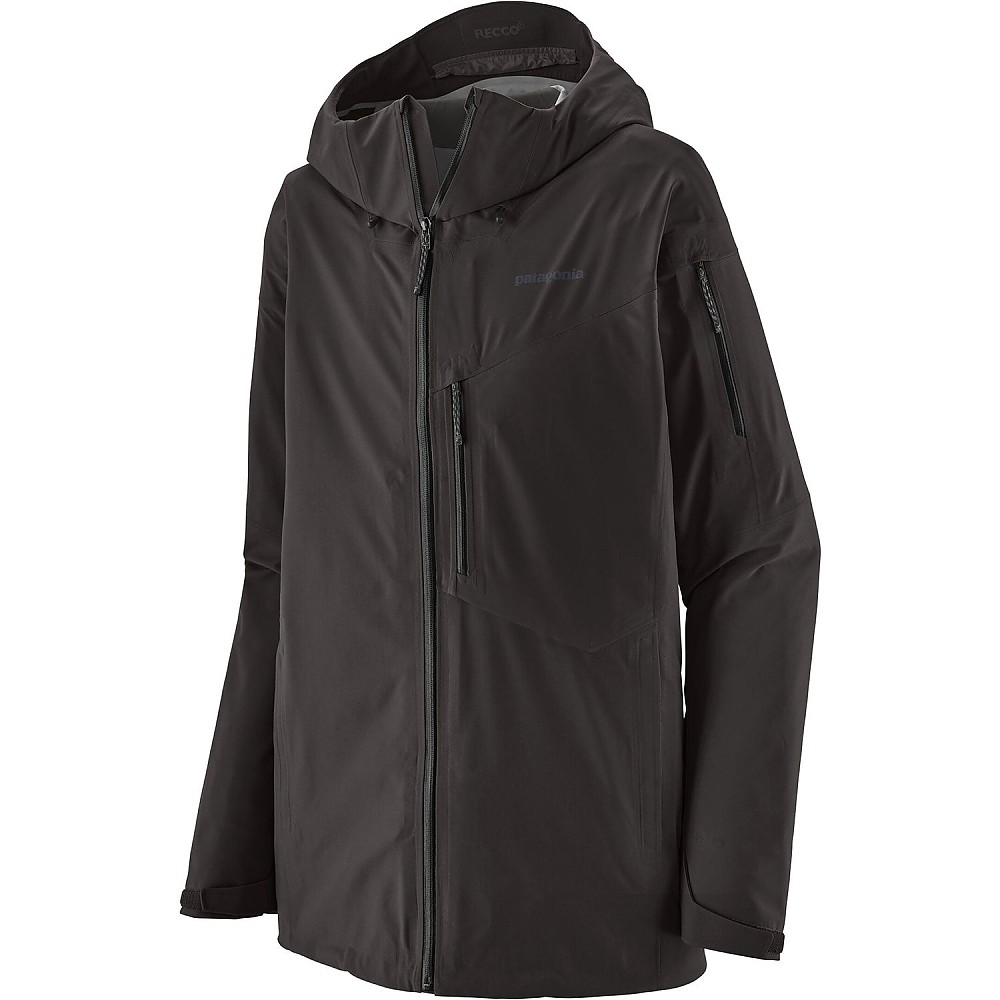
Patagonia's SnowDrifter Jacket is a full-featured snowsports jacket that could be stretched for use to hiking or backpacking.
Pros
- Lightweight compared to its peers
- Stretch fabric
- Flat, glued seams
- Generous sleeve length
- RECCO reflector
- 70% recycled fabric
- Available in men's and women's styles
Cons
- Pockets are not pack belt-compatible
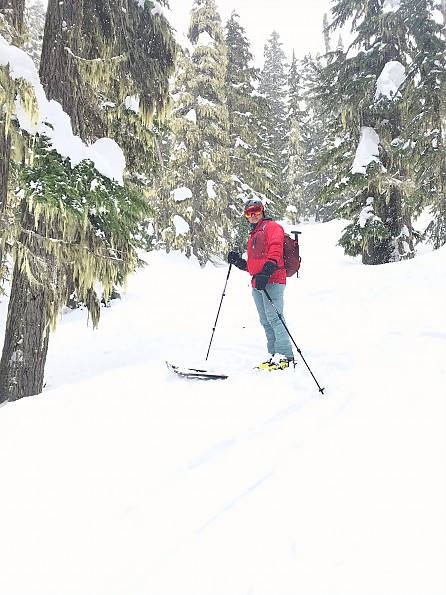
I don't remember if this is right BEFORE or right AFTER I crashed into a tree. Don't worry, the jacket is fine!
You probably want a light jacket that will keep you dry and give you the features you need. When those needs include a powder skirt, some stretchiness, breathability, durability, and a RECCO reflector, reaching for the Patagonia Snowdrifter Jacket is a smart idea. I'd love to tell you that this jacket does things that no other jacket does or that it's the best at one specific thing but, to be honest, it just does everything really well, but doesn't really stand out in any one category. It's just a solid, all-around jacket.
If you don’t ski or snowboard, I’d recommend stopping here and going to my GORE H5 Jacket review. This is a review for a snowsports jacket that has features that hikers and backpackers just don’t need, like a RECCO avalanche search reflector and a powder skirt. The Snowdrifter is at its best when used in backcountry skiing or at the resort.
From Patagonia: Our lightweight, backcountry-ready SnowDrifter Jacket combines stretchy fabric for uphill performance with serious storm protection to keep you dry and comfortable in all conditions. The SnowDrifter provides 3-layer H2No Performance Standard protection in a 70% recycled stretch fabric that’s ideal for human-powered powder pursuits. Fair Trade Certified sewn.
What I do in this jacket: This is a ski jacket so...I mostly ski in it. I also got talked into trying snowboarding once this year, which was a painful disaster. This ski season in the resorts was largely a bust so I headed into the resorts from the backside and also hit the backcountry to get my turns. I experienced lots of rain and snow in temps ranging from the mid-twenties to the upper-thirties.
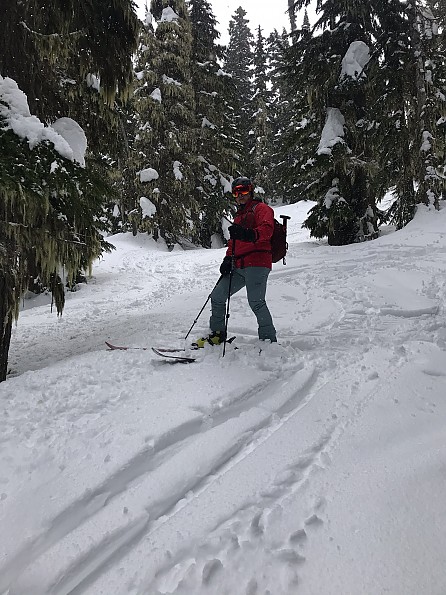 First day ever of tree-skiing in the BC.
First day ever of tree-skiing in the BC.
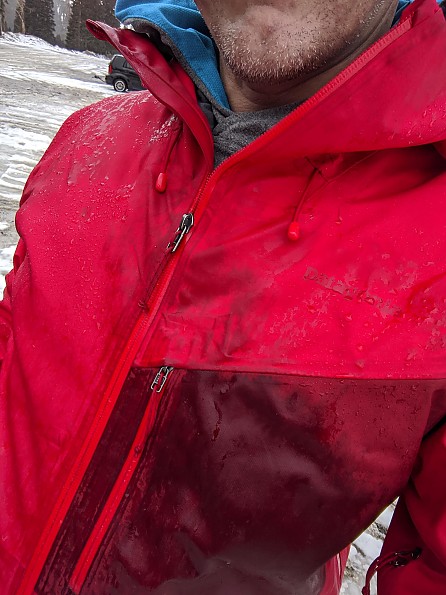 Read the comment below on the DWR finish. Even when wetted, the Snowdrifter kept me dry all day long.
Read the comment below on the DWR finish. Even when wetted, the Snowdrifter kept me dry all day long.
Waterproofness: Patagonia told me that the sample jacket I tested had an experimental durable, waterproof coating on it that was NOT the one used on the production model so I won’t discuss it here. The rest of the fabric performed its job well, keeping me dry on a particularly rainy ski trip on the Pacific Crest Trail on White Pass near Yakima, Wash. (elevation 4,500 to 5,500-ish feet).
Fit and Layering: Being a ski jacket I was not surprised that it was generously cut to allow layering. What did surprise me is that Patagonia called this their "regular fit." I'd call it "generous fit" and personally, I have a few extra pounds to lose myself.
I wore it with a baselayer and a light, insulating jacket underneath quite often. Using the fit chart I first ordered the LARGE size which was ridiculously big. I reordered the jacket in Medium and I’m happy with the fit.
With most brands, I seem to be between medium and large with medium sizes fitting me snugly. I'd have guessed that the Snowdrifter medium had been mislabeled and was actually a large the way it fit. The sleeves are extra long so I was pleased that it fit my ape-ish long arms. Also for me, being 5'10" tall, the hem reached to the bottom of my buttocks which helps in skiing crashes.
I wore the Snowdrifter with a Rab Strata Hoodie, a generic TNF hoody, and an OR Illuminate Down Hoody, all very comfortably with this jacket.
 Avalanche class at Mission Ridge in Wenatchee, Wash. Lots of digging and stretching. Rab Strata Hoody underneath. This was a training day; I usually wear the beacon harness UNDER my jacket.
Avalanche class at Mission Ridge in Wenatchee, Wash. Lots of digging and stretching. Rab Strata Hoody underneath. This was a training day; I usually wear the beacon harness UNDER my jacket.
 Layered with a hoodie underneath, playing some cornhole at the "Rails and Ales" event in Wenatchee, Wash.
Layered with a hoodie underneath, playing some cornhole at the "Rails and Ales" event in Wenatchee, Wash.
Stretch: I really appreciate a little stretch in my jackets and the Snowdrifter is exactly what I want. No, it isn’t as stretchy as a true softshell jacket, but there is enough stretch so that I was never impeded in my movement while messing with my boots or clicking into ski and snowboard bindings. The stretch is nice when you need to bend over to mess with snowboard or ski bindings.
Insulation: This jacket is uninsulated. It is sized to allow a base layer and a light insulating jacket underneath.
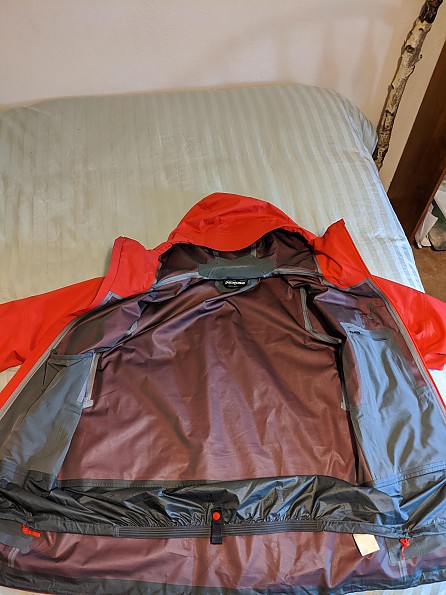 Snow skirt, inside pockets, uninsulated interior
Snow skirt, inside pockets, uninsulated interior
Wind Resistance: Being slightly stretchy and highly breathable, the Snowdrifter still blocks wind better than a softshell, but perhaps not 100 percent like a three-layer, old-school Gore-Tex jacket would. Being slightly less windproof than a rubber raincoat lets the fabric breathe and lets your sweat evaporate out while you are on the move.
 Josh saying, "Hey Jeff, how about another lap?" I unzip the front, open the pit zips, switch to skinning mode, and away we go!
Josh saying, "Hey Jeff, how about another lap?" I unzip the front, open the pit zips, switch to skinning mode, and away we go!
Breathability: With the giant pit-zips and the extremely breathable H2NO membrane, moisture management was never an issue. Forgive me when I don’t discuss it much because frankly, I skinned up and skied down 2,000 feet of vertical in this jacket and never felt the need to remove it. Of course my back where my pack was was wet with sweat, but that would happen no matter what.
Comfort: This SnowDrifter Jacket is a pleasure to wear; it moves with you and the stretch keeps it from binding when you reach or bend.
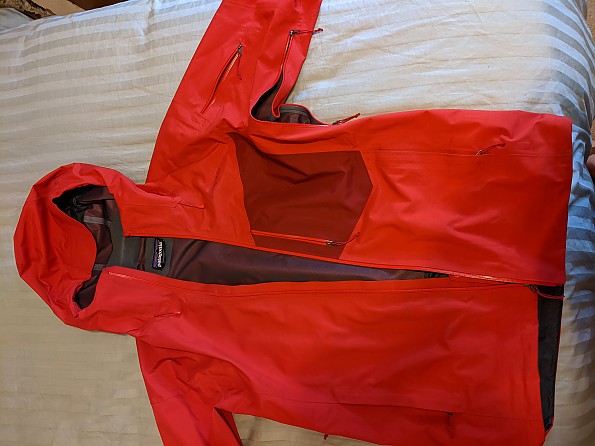 Pit zips, pockets, waterproof zippers
Pit zips, pockets, waterproof zippers
Features: A helmet-friendly hood that adjusts easily starts the Snowdrifter out in my “nice” list, as do the generous pit-zips, waterproof zippers, and glued, flat seams. The fantastic hood also has a stiffened bill to keep rain out of your face and adjusts to keep weather out while preserving your peripheral vision. The powder skirt isn’t removable but it is so light it would not help the weight much to take it off.
I wish the pockets were higher to work with a packbelt or climbing harness, but alas, once you are wearing a pack, they become unusable. A sleeve pocket and chest pockets (inside and out) hold keys, wallet, lip balm, cash, cell phone, ski pass and whatever other things you bring along. There’s a dump pocket inside for drying out gloves or a beanie (to wear in the lodge because, helmet hair) that will fit a one liter water bottle if you like.
If you want to have a slightly better chance of rescue in side-country skiing the Snowdrifter has a RECCO reflector built in. This device is designed to help ski patrol recover your jacket if you get buried in an avalanche.
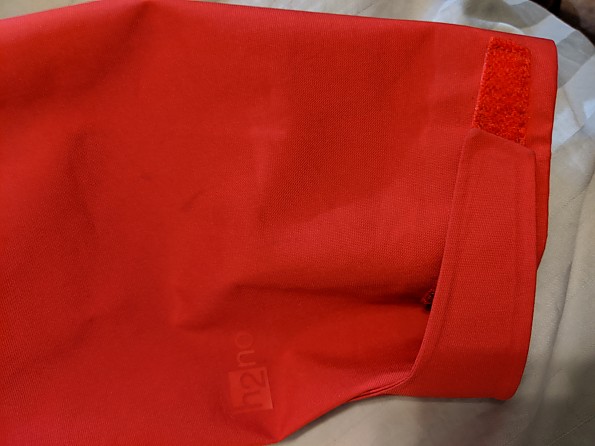 Adjustable cuffs and generous sleeve length. No inner elastic cuffs.
Adjustable cuffs and generous sleeve length. No inner elastic cuffs.
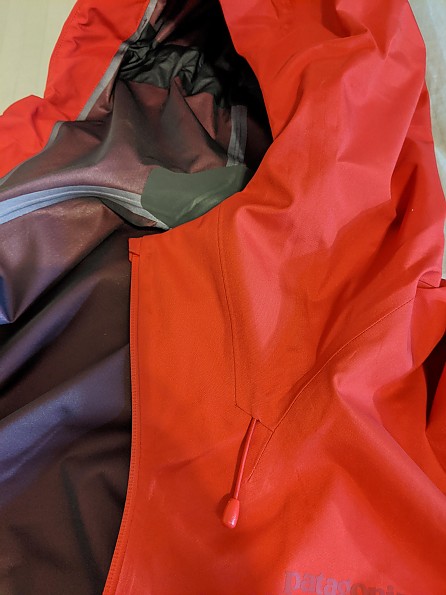 Hood adjustment #1, the toggles work reasonably well with gloves.
Hood adjustment #1, the toggles work reasonably well with gloves.
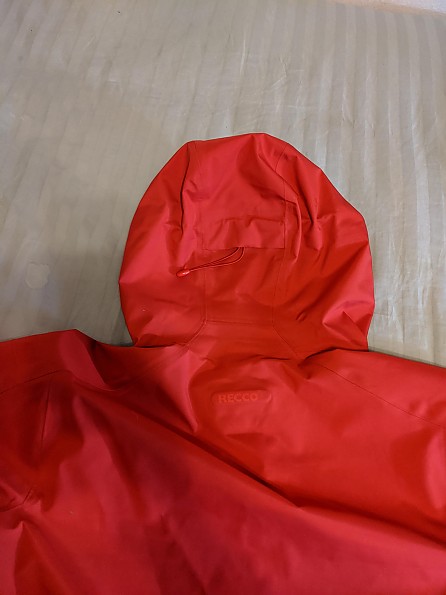 Hood Adjustment #2, RECCO reflector
Hood Adjustment #2, RECCO reflector
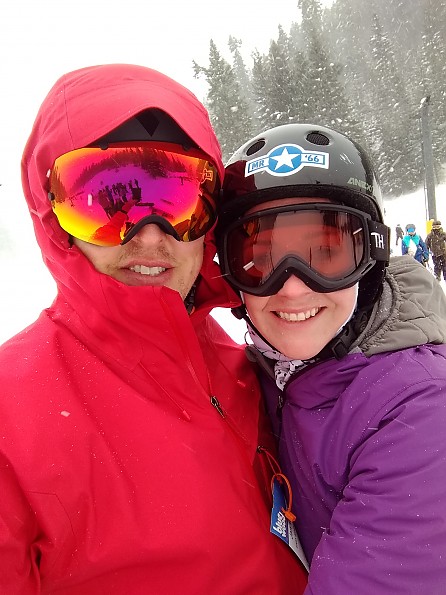 Helmet compatible hood. Snowboarding gave me a chance to test the Snowdrifter in crashes...LOTS of crashes! Heavy snow, temps about 25 degrees F. The stiffened brim on the hood keeps snow out of your eyes.
Helmet compatible hood. Snowboarding gave me a chance to test the Snowdrifter in crashes...LOTS of crashes! Heavy snow, temps about 25 degrees F. The stiffened brim on the hood keeps snow out of your eyes.
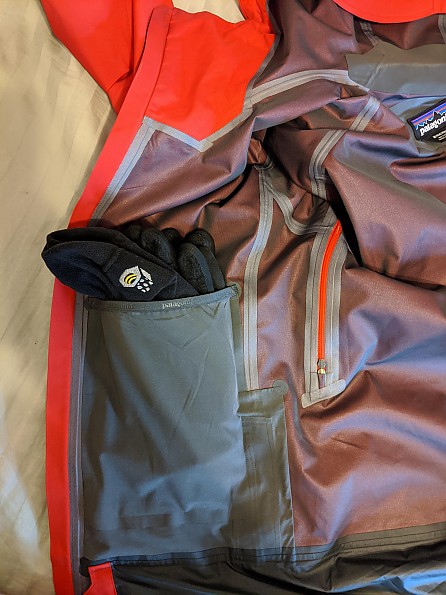 Room for the après beanie and mid-weight gloves. Perhaps keep a Nalgene here so it doesn't freeze. Would skins fit? Yes, but I don't put them in there because they're always so wet.
Room for the après beanie and mid-weight gloves. Perhaps keep a Nalgene here so it doesn't freeze. Would skins fit? Yes, but I don't put them in there because they're always so wet.
Price: $279 as of today, down from $399 msrp. This puts it in the same league as its peers from Outdoor Research, Mountain Hardwear, and Arc'teryx. If you ski in it twenty days per year, over ten years, at full, retail price, its costs you $2 per ski day; less than...well...ANYTHING at the ski resort.
Durability: With very few stitched seams to wear out and pop open I could easily see someone wearing this jacket till the year 2030. More than likely by then something shiny will catch your eye and you’ll Goodwill this jacket before then so someone else can love on it. It is well made and odds are, unless you are a pro skier or wear it to work, you won’t wear out this jacket.
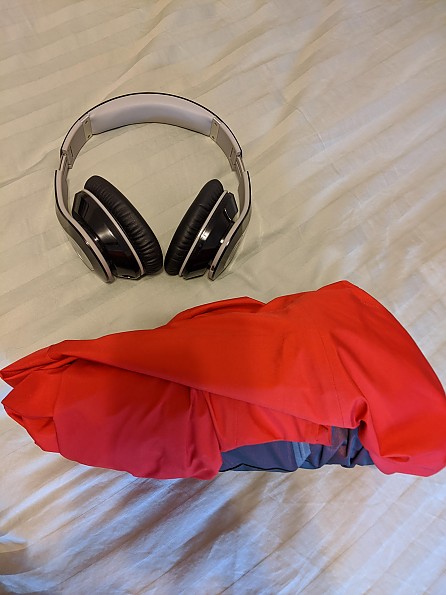 Rolled up, not bad for a ski jacket!
Rolled up, not bad for a ski jacket!
Packable size: This isn’t the first jacket I’d pick for fast, light climbs and hikes, but I smashed it down to the size of a Nalgene bottle with little effort. Pretty respectable. For the person who wants one jacket to ski and hike with and doesn’t mind the extra weight and space versus a dedicated UL shell jacket, this could work.
Weight: 20.7 ounces compared to 24.5 ounces for the Mountain Hardwear Boundary Jacket, 22 ounces for the Arc’teryx Sabre LT, and 25.5 ounces for the Outdoor Research Skyward II Jacket.
Best use: Well, obviously skiing and snowboarding. In-bounds and out-of-bounds this jacket is a winner. I took it snow hiking and it worked great. If owning a room full of outdoor gear and clothing isn’t your thing you could easily make this jacket work as a do-all piece for skiing, hiking, and climbing.
Style: I wore this jacket in town a bunch as well, around real people, up until the quarantine. The color I received for testing was called “Fire.” It got the approval from the house fashion consultants (wife and teen daughters). It also comes in black.
There is a matching Snowdrifter Bib pant that mates well with the jacket. I have high hopes for them, but I did not receive them for review.
 Rails and Ales snowsports event in Wenatchee, Wash. She agreed to be seen with me in public in this jacket. Style win!
Rails and Ales snowsports event in Wenatchee, Wash. She agreed to be seen with me in public in this jacket. Style win!
Druthers: The one thing I’d change on this jacket is to make the pockets higher so I don’t lose them under a climbing harness or packbelt.
Conclusion: If you need a waterproof, breathable snowsports jacket that is also light enough to take backpacking, the Snowdrifter is a great pick!
Background
I'm a climber, skier, mountaineer, hiker, trail runner, and father of eight. I'm kinda busy. I've owned several hard shells and Gore-Tex products as well as jackets with other waterproof-breathable membranes. I've been reviewing gear on Trailspace since 2010.
Source: received for testing via the Trailspace Review Corps
(Sample for testing and review provided by Patagonia)
Your Review
Where to Buy
You May Like
Specs
| Men's | |
|---|---|
| Price |
MSRP: $399.00 Current Retail: $202.05-$449.00 Historic Range: $193.05-$449.00 |
| Weight |
587 g / 20.7 oz |
| Fit |
Regular Fit |
| Materials |
H2No Performance Standard shell: 3-layer, 5-oz 75-denier 100% polyester (70% recycled) solid stretch ripstop with a DWR (durable water repellent) finish and a soft polyester knit backer |
|
Fair Trade Certified sewn |
|
| Women's | |
|---|---|
| Price |
MSRP: $399.00 Current Retail: $246.95-$336.73 Historic Range: $124.99-$449.00 |
| Weight |
510 g / 18 oz |
| Fit |
Regular Fit |
| Materials |
H2No Performance Standard shell: 3-layer, 5-oz 75-denier 100% polyester (70% recycled) solid stretch ripstop with a DWR (durable water repellent) finish and a soft polyester knit backer |
|
Fair Trade Certified sewn |
|


